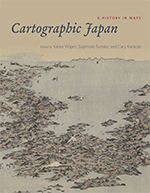如果你逛过日本的书店,你或许会发现书店里好像有特别多针对旅游指南、行走地图以及地图的书。年轻的日本孩子在很小的年龄就学会如何画出教室以及学校的地图。日本的老年人会花无止境的时间研究古老的地图。先进的制地图学者会被邀请上电视节目,而收藏家们会走偏各地寻找稀有的地图。日本人特别喜欢制造以及收藏地图,所以有什么比透过地图是更好的方式来了解他们的历史?
一千年前,地图在日本不是像现在这么炙手可热。当时只有最精英阶层的人物才会接触到地图。只有在最近400年来地图才在日本成为这么受人民迷恋的物品。日本的历史经历了许多地理以及文化上的改变,而书中收入的地图都一一记录了这个国家的进化。这本书分析了超过100张地图,从1500年代到现代,全部都可以当作是看见日本的窗口。
本书总共有47位贡献者,来自日本、北美、欧洲以及澳洲,他们帮助分析讲解所有的地图,包括当时的历史背景、地图如何制造、当时如何被解读以及使用。本书适合热爱历史以及地图的读者们!
关于编辑:
Kären Wigen是美国史丹福大学的历史教授。
Cary Karacas是纽约城市大学CUNY College of Staten Island的地理副教授。
好评:
Andrew Gordon, Harvard University
“A treasure trove of short essays on the history of mapping, Cartographic Japan offers a rich range of insights in the mapping of Japanese history across a remarkable range of scales. Among them are neighborhoods, markets, workplaces, cities, regions, colonies and empire, cosmology and religion, and of course various apprehensions of the nation-state. This book belongs on the shelf of anyone who teaches about Japan or who is fascinated by its history, as well as all those fascinated by the search for meaning in maps.”
Jordana Dym, Skidmore College
“Cartographic Japan revels in how deeply maps have been embedded in organizing Japanese society and its literal and figurative boundaries, shaping knowledge and policies, and even saving lives, for the past fifteen hundred years. Whether carefully describing original mapmaking traditions or explaining why historical maps reprinted in the 1960s unleashed controversy, the fifty-eight short chapters and accompanying illustrations bring Japanese history to life in stories spanning space and time. The authors of this important and ambitious contribution offer scholars, students, and map buffs alike a privileged seat at the banquet table of cartographic history, with access to the plans, hopes, and dreams of an impressive range of Japanese leaders, intellectuals, merchants, and citizens and a handful of the foreigners who made maps matter.”
Thongchai Winichakul, University of Wisconsin–Madison
“If a picture paints a thousand words, this book shows how maps tell countless stories of Japan’s past. Not only do the fifty-eight short essays and multitude of illustrations in Cartographic Japan offer windows into particular moments in Japan’s history, but they also form fascinating visualized narratives. It is an innovative and enjoyable approach to imagining Japan’s past beyond simply the pragmatic function of these maps.”





